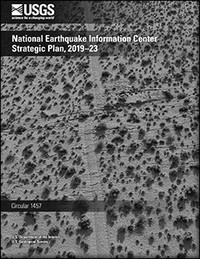
Product Details
- Product Number
- 530202
- Series
- CIR-1457
- Scale
- NO SCALE
- Alternate ID
- 21-1457
- ISBN
- 978-1-4113-4326-9
- Authors
- DAVID J WALD
- Version Date
- 01/01/2019
- Countries
- USA
- Media
- Paper
- Format
- Bound
Additional Details
- Description
-
First posted September 13, 2019
For additional information, contact:
Director, Geologic Hazards Science Center U.S. Geological Survey Box 25046, MS 966 Denver, CO 80225
Executive Summary
Damaging earthquakes occur regularly around the world; since the turn of the 20th century, hundreds of earthquakes have caused significant loss of life and (or) millions of dollars or more in economic losses. While most of these did not directly affect the United States and its Territories, by studying worldwide seismicity we can better understand how to mitigate the effects of earthquakes when they do occur within U.S. borders. Within the U.S. Government, this mandate falls on the U.S. Geological Survey (USGS) National Earthquake Information Center (NEIC), which has the statutory responsibility for monitoring and reporting on earthquakes domestically and globally.
The NEIC has been operating since 1966, and throughout its history has been recognized as a world leader for earthquake information. For much of this time, NEIC has been cooperating with a number of regional seismic networks (RSNs) which operate in areas of heightened seismicity in the United States. In 2000, the Advanced National Seismic System (ANSS) was founded as a cooperative umbrella for earthquake-related data collection, analysis, and dissemination in the United States, thereby promoting advanced interoperability between the NEIC and RSN partners. The NEIC also cooperates and coordinates with dozens of global seismic networks. At present (2019), NEIC acquires real-time waveform data from more than 2,000 seismic stations worldwide, contributed from more than 130 seismic networks.
Since 2006, the NEIC has operated on a 24-hour, 7-days per week (24/7) basis, and reports on about 30,000 earthquakes per year. Soon after the occurrence of a significant global earthquake, notifications are issued to government representatives, aid agencies, the press, and members of the general public by the Earthquake Notification Service (ENS), electronic feeds, and through the USGS Earthquake Hazards Program (EHP) website. Event-specific web pages provide detailed source parameter information outlining the location and magnitude of the earthquake, including more detailed source characteristics like moment magnitude and focal mechanisms and finite fault solutions. Further, NEIC produces a suite of real-time situational awareness products, including ShakeMap, ShakeCast, Did-You-Feel-It? (DYFI?), and Prompt Assessment of Global Earthquakes for Response (PAGER), to characterize the shaking resulting from the earthquake and the impact it is likely to have on nearby populations and infrastructure. All of these products are ultimately archived in the ANSS Comprehensive Catalog (ComCat), hosted and served by the NEIC.
The NEIC also pursues an active research program to improve its ability to characterize earthquakes and understand their hazards. These efforts are all aimed at mitigating the risks of earthquakes to humankind.
To maintain its prominent position in earthquake monitoring, the NEIC must continue to evolve, concurrently improving its operations and 24/7 robustness, streamlining services and infrastructure, and keeping pace with research and innovation in the field of seismology. This document outlines how the NEIC might best achieve such goals, by describing specific avenues and opportunities for development in the next five years (2019–23).
Several key areas of operational and research focus are identified in this plan as being of the highest importance. First, NEIC must finalize improvements to its regional monitoring capabilities, including the implementation of a variety of improved earthquake detection and association algorithms. One of the most exciting avenues of recent research expansion in earthquake monitoring has involved the use of machine learning; NEIC must explore the benefits of machine learning for improved earthquake detection and source characterization. NEIC also needs to address issues related to the timeliness of earthquake information, exploring the benefits of distributing information as it becomes available, rather than when certain quality criteria are met. To that end, the incorporation of real-time Global Positioning System (GPS) data into the NEIC operational workflow will help improve the speed and accuracy of information for moderate-to-large earthquakes. Finally, NEIC should explore how to further expand and improve the quality and content of the products served during earthquake response efforts, including the generation of new earthquake sequence-specific products, adding an evolutionary component to earthquake information, and continued improvements to earthquake impact products.
- Height In Inches
- 11.000
- Width In Inches
- 0.010
- Length In Inches
- 8.500
- Two Sided
- Yes
- Pieces
- 1
- Languages
- English



